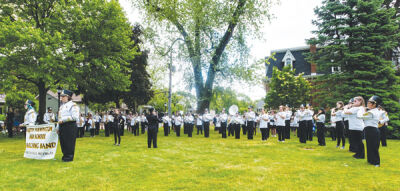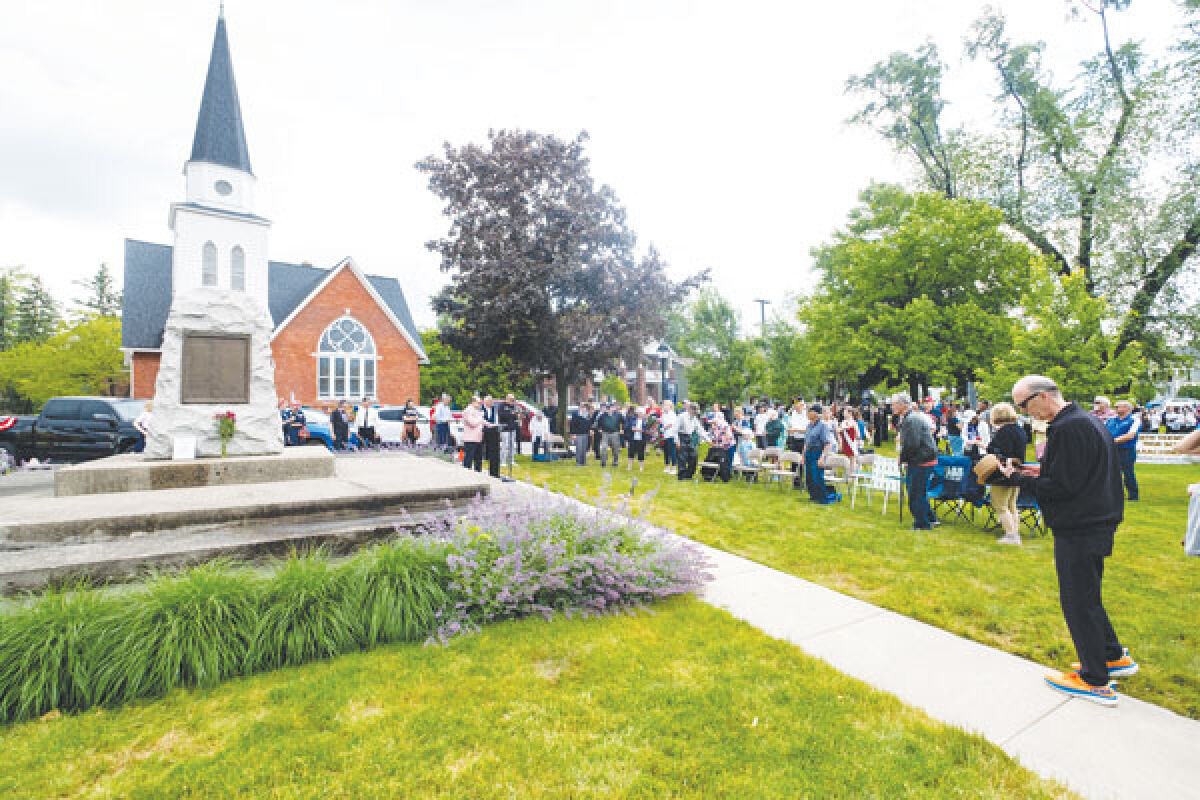
Farmington resident Dick Cook said he was only 1 when a Japanese Fu-Go balloon bomb reportedly landed near the property where he resided with his family. He is pictured at a ceremony May 27.
Photo by Brian Wells

The North Farmington High School marching band performs May 27, which is the day a plaque was installed in Memorial Park as part of the Michigan World War II Historic Trail.
Photo by Brian Wells
FARMINGTON — A trip to Memorial Park in downtown Farmington now includes a local history lesson for those who happen to take notice of a plaque that was recently installed.
A World War II commemorative plaque was unanimously approved by Farmington’s City Council members recently.
The plaque is part of the Michigan World War II Historic Trail, which is a program for communities across the state to recognize specific points of interest related to World War II.
Farmington was the first community in the state to have a plaque installed as part of the Historic Trail.
The plaque helps relay the story of a Japanese “Fu-Go” balloon bomb that landed on the property of John T. Cook, near Gill and Eight Mile roads, in March, 1945.
According to a press release from the city of Farmington, during World War II, the Imperial Japanese Army launched more than 9,300 Fu-Go bombs, which were balloons made of paper and potato paste that were filled with hydrogen and to which were affixed incendiary explosives.
They were released from the island of Honshu and were timed to ride the jet stream to the United States.
Approximately 280 balloons made it, with an Army Services report concluding that one of them landed in Farmington.
“Fortunately, the ensuing fire lasted only a few minutes and caused no damage,” the release states.
Dick Cook is John T. Cook’s son. He said that their neighbor was a Michigan State Police trooper, and the neighbor sent out military intelligence agents to talk to the family.
“I was only a year old, but what happened was when that bomb landed in the garden, the … State Police guy was actually living next door, and the FBI came out,” Dick Cook said.
According to Cook, the incident was discussed at the dinner table of the home he lived in with his dad, mom and brother, but they were supposed to “keep our mouths shut.”
“Nobody wanted to know that the Japanese bombs had gotten this far, so it was a hush-hush thing, but it was pretty scary at the time, because my parents and grandparents were living next door to each other on Gill Road there, and they were concerned about it,” Cook said. “My dad even handled the thing a couple times. … It was a big mystery what happened. When they came out, they found out it was a Fu-Go bomb.”
Cook said that the bomb landed in a garden between his parents’ and grandparents’ home, which both still exist.
“It wasn’t like anybody knew that the bomb dropped, except it was in the garden,” Cook said. “They didn’t know what it was, and they went through the channels (because) it looked mysterious.”
Cook still resides in Farmington. He taught history at Farmington High, where he also had success as a wrestler before going on to coach the sport there and at Harrison High and North Farmington High.
He said his dad was a cooling engineer at Chrysler, and his mom was a secretary.
Cook said that the plaque is nice because his dad’s name is on it.
The plaque may help convince skeptics who might otherwise have a hard time believing Farmington’s connection to World War II.
“How many people today, if you say, ‘When the Japanese bombed Farmington’ – they won’t believe you anyway,” Cook said. “Very few towns around here have a history like Farmington does.”
The Historic Trail is a project of the Michigan WWII Legacy Memorial, which is located near 13 Mile Road and Woodward Avenue in Royal Oak.
Judy Maten is on the board there, and it is her intent for other communities to become part of the Historic Trail and share their own stories.
“Across the state we had manufacturing plants and people that really tell that World War II story,” Maten said. “The intent of the Historic Trail is to bring the story home. So in the case of Farmington, they had a unique World War II story with the Japanese balloon bomb that landed there, so that’s kind of a World War II story that’s unique to Farmington. This trail will take the story of World War II to significant places throughout the state, all leading back to the main memorial, which is in Royal Oak.”
Maten shared more of the history behind the Fu-Go bombs.
“They were weather balloons, basically, with bombs in them,” she said. “They launched (them) into the airstream hoping that the jet streams would carry them wherever. So it was really a scare tactic … to set fear into communities. … There was one on the west side of the state where one of the bombs landed as well.”
According to Maten, the Fu-Go bombs had a primary target.
“It was the Pacific Northwest’s forests that they were really trying to set on fire, (but) the jet stream carried them … elsewhere. That’s how they landed here,” she said. “It didn’t catch the forests on fire; it didn’t achieve what they wanted, but it … put everybody on alert here.”
It is her aspiration for the Historic Trail to lead those who travel on it to the Michigan WWII Legacy Memorial in Royal Oak.
“The trail is part of our organization, but it’s a project within the memorial itself, so that we can take the memorial and bring it across the state,” Maten said. “The plaques then, being in individual cities and communities, will point back to the memorial, because it is our hope that it is a travel destination for people across the state.”
Maten said that the Michigan WWII Legacy Memorial is a 3/4 acre site that is about a third complete.
One of the aspirations for the site is for it to eventually include an amphitheater.
Maten said that it is a $3 million project that is being privately funded, with about $2 million left to go on it.
The Historic Trail could help attract more interest and funding for the Michigan WWII Legacy Memorial.
“The trail will bring the World War II story and awareness of the World War II story to the hometowns where it happened,” Maten said. “As we have that memorial in Royal Oak, we also want communities throughout the state to know their story, and that’s the intent of the Historical Trail.”
Farmington City Manager David Murphy shared his thoughts about the installation of the plaque in Memorial Park.
“This is a really interesting story that needs to be remembered,” Murphy said in a press release. “This legacy memorial recognizes Farmington and its footsteps on Michigan’s World War II Historic Trail.”
Maten said there are “fascinating stories that we hope to bring to life through that trail,” and she recognized Farmington’s role in the process.
“Farmington is the first,” she said. “We’re thrilled that they launched the trail for us, and we’re excited to see where the trail goes. We thank Farmington for their support.”
For more information about the Michigan WWII Legacy Memorial, visit michiganww2memorial.org.
 Publication select ▼
Publication select ▼






















